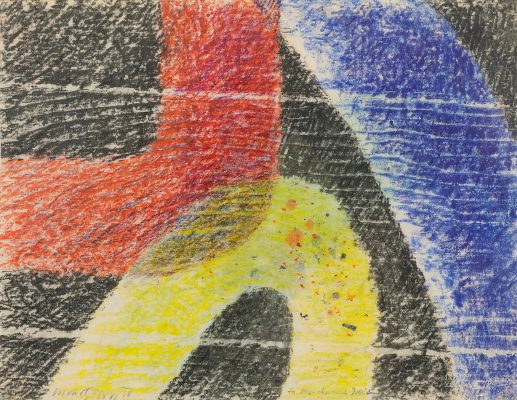Bhanu Kapil is a fantastic performer. I saw her at the London Review Bookshop in 2019. She had with her an orange Sainsbury’s carrier bag, a large jar filled with red glitter (she assured us it was ‘dolphin friendly’) and a bottle of water. She also brought a circular stainless steel tray, like the kind a cater-waiter might wield. She tipped the contents of the bag – compost, moist-looking, a rich, cacao brown – onto the tray. She tipped in the glitter. She poured the water over the lot. She mashed it all up with her hands.
Before Kapil did this, she invited the new cohort of Ledbury Critics – a programme founded in 2017 to increase the number of poetry critics of colour in the UK – of which I was one, to stand up from our seats in the audience. ‘And so I ask’, she said to us: ‘What do you inherit? What do you reproduce?’ Kapil then invited us to come up and be anointed by the mud-glitter-mush. She smoothed it over the skin of our forearms. I was last. To me, Kapil said: ‘This is spa treatment and exorcism in one’.
After she had smoothed the mud over us, she took the tray outside and tipped its contents into the street.
*
Kapil’s win of the 2020 T.S. Eliot prize for How to Wash A Heart (2020), a long, halting poem which uses the host/guest dynamic as a parable of ethnonationalist immigration policies, brought greater attention to a career of reverberative experimental poetry. Her ways of writing about girlhood, the body, trauma and its transferral, violence – the horrific and the subtle – have rippled far and wide. Over twenty-odd years, she has attracted a devoted cult following, mainly in the US where her early books were published, and where she taught for just as long.
‘Since moving to the US’, wrote the poet Jay Gao in an email to me (he recently left the UK to study at Brown University), ‘I have discovered that Bhanu Kapil is, perhaps, the only contemporary British poet who is regularly invoked by my American peers whenever our talk turns towards experimental and interdisciplinary poetics. The fact that The Believer once held a three-day roundtable to discuss her work, that she won a big American literary prize before a British one, says a lot about her influence.’
Kapil’s work is fervently beloved: many will cite her as ranking among what Dana Ward describes as ‘the many gendered-mothers’ of their hearts. ‘Bhanu’s work does not shy away from violence, it walks into the violence and, again, in a way I’ve never quite seen before, tries to heal it’, Amina Cain said during The Believer roundtable, which took place in 2016. Writing in Lithub, poet Lucas de Lima describes Kapil’s ‘continuous relocation of the body and distribution of the soul’ as ‘maybe the deepest move a writer can make against the enclosures of the state’. Her blog (since deleted by Kapil), ‘Was Jack Kerouac a Punjabi?’, reached almost two million readers.
It is noteworthy, then, that How To Wash a Heart began its life in the UK, published by Liverpool University Press’s Pavilion Poetry. This represents a pivot in Kapil’s practice: after decades of living and working in the United States, she has also returned to the UK, a move that has coincided with her receiving greater recognition in her home country.
Britain – post-imperially melancholic, unwillingly enmeshed with the traumas of its former colonies – has been a perennial subject for Kapil, and living in the United States gave her the necessary distance to contemplate it. ‘It’s hard to study something by just standing in front of it’, she said in an interview with Sandeep Parmar for The Guardian in 2021. ‘I like the mixture of looking at something from afar, and then, the near ground. […] I can observe the stains, the cracks, then replenish myself by standing barefoot on the earth, which is the dirt of the place I am from.’
Kapil was born in Britain to Indian parents. Her mother fled the violence of Partition as a child, an abiding memory of which recurs at intervals. In Schizophrene (2011), a fragmentary book-length poem in eight parts, and an attempt to explore the psychological after-effects of Partition, Kapil writes:
My mother’s mother put a hand over my mother’s mouth, but my mother saw, peeking through the slats of the cart, row after row of women tied to the border trees. ‘Their stomachs had been cut out’ said my mother. This story, which really wasn’t a story but an image, was repeated to me at many bedtimes of my own childhood.
Sometimes I think it was not an image at all but a way of conveying information.
How to Wash a Heart speaks deliberately to the specifics of Britain: its racism, and its reception of immigrants. The book’s premise is simple: a non-white guest is put up by a white host. The key phrase is ‘put up’, but should really be ‘put up with’: white hegemony’s attitude to the person or group of colour is one of mere tolerance, at times through gritted teeth. The poem is structured as a dialogue, in which the onus is on the guest to soothe the host’s conscience. ‘As your guest, I trained myself / To beautify / Our collective trauma’, Kapil writes, ‘In that moment, I understood that you were a wolf / Capable of devouring my internal organs / If I exposed them to view’. In narrow columns of text, a slow build to breaking point is effected.
In the afterword, Kapil explains that she was inspired by a news story about a white couple who took in ‘a person with a precarious visa status’ in California. ‘I was so struck by the mother in the newspaper photograph,’ Kapil writes, ‘the taut muscles around her mouth as she smiled’. This underlying tension interested Kapil, along with the performance of generosity and virtue, the ‘ornate way of describing the hospitality that she was offering’:
It’s exhausting to be a guest
In somebody else’s house
forever.
Even though the host invites
The guest to say
whatever it is they want to say,
The guest knows that host logic
Is variable.
Prick me,
And I will cut off the energy
To your life.
Kapil explored a version of this sentiment in her 2009 book humanimal, which reexamines the early twentieth-century story of Amala and Kamala, two girls found living with wolves in Bengal in 1920. The book is composed of two competing sequences of prose segments, giving the sense of different voices speaking at once. It contains visual art, too: maps of London overlaid upon close-ups of scarred limbs.
After killing the wolves, missionary Joseph Singh brought the girls back to his orphanage and tried to get them to walk upright, wear clothes and eat human food. Kapil’s source text was Singh’s diary, the only source text available for the story (consequently, the veracity of these events has since been called into question). Kapil travelled to the site of the orphanage in Midnapore, and met Singh’s grandson: ‘it was he who placed the blurry photographs, which sections of this work are written from, in my hands’. One of these features on the cover: a girl in a white dress reaches into a tree, ‘her elbow thick as a knot. I said it was cartilage – the body incubating a curved space, an animal self’. Seen walking to Church on Palm Sunday, Kamala’s ‘arms extend stiffly from her body to train them, to extend’,
Unbound, her elbows and wrists would flex then supinate like two peeled claws. Wrapped, she is a swerve, a crooked yet regulated mark. This is corrective therapy, the fascia hardening over a lifetime then split in order to re-set it, educate the nerves. […] She was seven when her Father found her, coiled in a den. A tall, extremely handsome Father, sidetracked from his Mission – dressed in black despite the heat – caught her in a bed-sheet, and wrote: ‘I cut a hole and removed her from the cave’.
Singh oversaw the training of these curved limbs, the shaving of matted hair, the strapping down to beds and the feeding of tea squeezed through a rag:
They strapped her down to a limited table where a knife spun in a jar of blue water. […] Like an angel, the priest fed Kamala from a coil of linen, squeezing water into her open mouth. She spat it out and so the doctor came with his packet of edges. Dipped one into the glutinous foam and began. Her arms first. The thick dorsal hair, ashy. Her legs first and then her skull.
humanimal and How To Wash A Heart ask of the reader: What is love, or civilisation, and what is violence? What is hospitality? What does the guest owe the host, or vice versa? To whom do you belong? Is it even a question of belonging? How does one become a girl?
*
In Threads, a 2018 pamphlet written collaboratively by Sandeep Parmar, Bhanu Kapil and Nisha Ramayya, Kapil and Parmar write of the lyric ‘I’ in the British tradition:
[I]t is impossible to consider the lyric without fully interrogating its inherent premise of universality, its coded whiteness. […] how do poets of colour themselves differently embody the ‘I’? Or does it come to embody us? Is it no more than the dead metaphor of our failed universality, of our being as other? […] An alternate space of becoming requires a rejection of culture that supersedes the complexity of the individual. To the violence of fixed binaries in the lyric, self and other, nomadic consciousness offers an aesthetic and political solution.
Threads was written as a response to the literary establishment’s encoding of the ‘Other’, which has two predominant manifestations. On the one hand, this Othering involves a confinement to the beautification of trauma. It’s a long-running and embittered joke, in certain quarters, that work by and about people of colour has to be ‘heartbreaking’, a word which recurs again and again in cover quotes. The person of colour in the literary marketplace is expected to excavate painful experiences in order to make them eligible for a presumed, majority-white readership – or, indeed, to have this pain emphasised to the point of reduction by critics. There is also the related limitation: that the poet of colour is penned in to pointillist, prettified exoticisation (embodied in another joke, this time about the prevalence of mangoes in diaspora poetry).
This latter way of categorising the ‘I’ of the poetic speaker can be seen in the reception of the work of Sarah Howe and Will Harris – despite the two poets actively sparring with the Othering tendency. Kate Kellaway, writing in The Guardian, lauded Howe for the ‘oriental poise’ of her 2015 collection Loop of Jade; Harris’s work has been compared to ‘a fine silk print’. Yet in their poems, the ‘I’ is shifting, unstable, forever loping around its own perimeters and cutting the fence, and in so doing, signposting new and joyously plural ways of being and becoming. ‘I […] need a voice capacious enough to be both me and not-me’, writes Harris in Rendang (2020), ‘while always clearly being me’. Howe’s many iterations of the ‘I’, meanwhile, wink from behind Jorge Luis Borges’s fictitious taxonomy of animals, the Celestial Emporium of Benevolent Knowledge, from his 1942 essay ‘The Analytical Language of John Wilkins’. Borges’s essay highlights the absurdity of the taxonomical impulse, with fourteen fantastical categories intended to encompass all animals – including ‘mermaids (or sirens)’, ‘those that have just broken the vase’, and ‘those that from afar look like flies’ – categories which Howe used to structure her collection.
For Kapil, the drawing of binaries, of hard lines, of borders, is what hampers becoming. Here she is in Schizophrene:
It is psychotic to draw a line between two places.
It is psychotic to go.
It is psychotic to look.
Psychotic to live in a different country forever.
[…] The compelling conviction that something has been lost is psychotic.
Schizophrene is arguably Kapil’s most influential work to date. ‘For some years I tried to write an epic on Partition and its trans-generational effects: the high incidence of schizophrenia in diasporic Indian and Pakistani communities; the parallel social history of domestic violence, relational disorders, and so on’, she writes in the preface. The book which follows is very little about schizophrenia, but is instead a litany of gentle images with a soft prosody: the colours of skies seen from boats, stems of flowers, the sounds bamboo makes when touched. These images, delivered in isolated half-lines or short gestures of text, also arose from her particular process:
Towards the end of this project, I felt the great strength of the page: its ability, as a fibrous surface, to deflect the point of my pen. The paper, and then the screen, as weirdly reflective, repelling the ink or the touch. On the night I knew my book had failed, I threw it – in the form of a notebook, a handwritten final draft – into the garden of my house in Colorado. Christmas Eve, 2007. It snowed that winter and into the spring; before the weather turned truly warm, I retrieved my notes, and began to write again, from the fragments, the phrases and lines still legible on the warped, decayed but curiously rigid pages.
This is a text made from the flotsam of another text; the stones pushed up through the ground by the frost; a story, to borrow from the afterword of M. NourbeSe Philip’s book-length poem Zong! (2008), ‘which cannot be told and yet must be told’; an anti-epic, if you will. Through her performances, what she describes as her ‘novel-shaped space(s)’, her prose poems and fragments, Kapil was one of the writers who validated my own taxonomical claustrophobia in the face of people’s insistence that I put a precise term to what it was I was writing. Her oeuvre is dedicated to the psychosis induced by the violence of drawing lines and making categories, a project mirrored in the slipperiness of her forms.
*
Ultimately, what I love about Kapil is her concision, arrived at through processes of sifting which refuse to be rushed, which challenge us all to fully answer the question: What do you inherit, and what do you reproduce? The power of Kapil’s writing lies in her ability to evoke violence with a gentle touch. In the endnote to Schizophrene, she writes:
From cross-cultural psychiatry, I learned that light touch, regularly and impersonally repeated, in the exchange of devotional objects, was as healing, for non-white subjects (schizophrenics) as anti-psychotic medication. In making a book that barely said anything, I hoped to offer: this quality of touch.
One is wary of setting too much store by this, but in her early years in the US, Kapil trained at the Boulder College of Massage Therapy and worked as a bodyworker for twelve years. This light touch, then, can be said to come from a tangible practice as a massage therapist (see also: mud mush smoothed over the skin of my arm), and also the poetic impulse to keep returning to the knots, to work on them until they release their toxins.
That night at the LRB shop, I was newly sure of myself as a critic, but less so as a poet. I was in the final stages of writing what has since become a book, Amnion (2021), but it was throwing up questions that Kapil’s work challenged me to answer. I am white-passing, and when she told me, as she smoothed the mud over my arm, that she was exorcising me, I felt it as an attempt to draw the whiteness out from me. By ‘whiteness’, I mean whiteness as the solipsistic enterprise which props up racism, as a deliberately maintained epistemological limitation. ‘[A] big part of white supremacy is how whiteness becomes its own complete knowledge system’, the poet Chen Chen wrote in a tweet in March 2021: ‘you don’t have to learn anything new about people’s lives, struggles, histories. all you have to do is believe what you already believe. learning anything new is what offends’. Whiteness, in the words of the author-activist Shola Mos-Shogbamimu, as ‘the arrogance of your ignorance’. The work of a lifetime being, therefore, to inquire of oneself: what do you inherit, and what do you reproduce?
For Amnion, I wanted something of Kapil’s gentleness in the face of complicated pains. My family history had its own fractures, complicated ones which branch off in all directions. My Filipino family on my father’s side, for instance, had status, derived through twofold means. The first was wealth (the opium trade; land). The second was a claim to being descended from the sister of José Rizal, national hero of the Philippines. My grandmother’s elopement (and pregnancy) aged nineteen represented a threat to this status. She was disinherited and banished to Spain, where she has lived ever since.
I came to Kapil after much of Amnion had formed, but her work gave me a firmer articulation of what it was I was trying to do with this complex bequest and my qualms with it (this is only part of the picture – I haven’t even touched on my mother’s side). Kapil demonstrated a level of care in the laying out of delicate and various hurts, she modelled a mode of excavation involving fine-haired brushes and the soft smoothing away of the soil, rather than the plunderous extraction of family history for personal gain. Her books are spaces to rest, to lay down your armfuls of things. Now that she finds herself back here, on the near ground of Britain, it will be a joy and a wonder to see what she makes of it and our barrage of inheritances.




